
by Molly Jameson | Nov 27, 2017
 If you are a regular reader of Gardening in the Panhandle, you know that this e-newsletter covers many topics related to ornamental and vegetable gardening, Florida-friendly landscaping, pest management, and lawn and garden fertility.
If you are a regular reader of Gardening in the Panhandle, you know that this e-newsletter covers many topics related to ornamental and vegetable gardening, Florida-friendly landscaping, pest management, and lawn and garden fertility.
But did you also know that UF/IFAS Extension in the Florida Panhandle has four other E-newsletters covering topics such as Florida agriculture, wildlife and natural resources, 4-H youth, economic well-being, health and nutrition, and overall life quality for individuals and families?
These other E-Extension in the Panhandle newsletters include Panhandle Agriculture , Panhandle Outdoors, 4-H in the Panhandle, and Living Well in the Panhandle.
[notice]Additionally, UF/IFAS also has an extensive collection of publications on many of these e-newsletter topics. If you haven’t already, check out the Extension Data Information Source (EDIS) website. It is a comprehensive, single-source repository of all current UF/IFAS numbered peer-reviewed publications. Visit EDIS for a complete listing.[/notice]
As a Gardening in the Panhandle enthusiast, here is a list of horticulture and gardening related EDIS publications you might find useful:
Vegetable Gardening
Home Lawns and Landscapes
Soil and Fertility
Pest Management

by Sheila Dunning | Nov 13, 2017
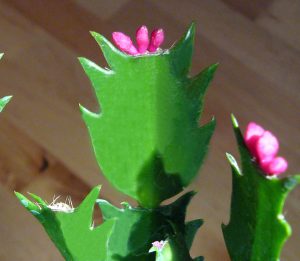
University of Minnesota Extension
Julie Weisenhorn
Is your grandmother’s pass along Christmas cactus blooming really early? Do the leaf segments have “teeth” along the edges? Are the “stringy things” sticking out of the flowers yellow in color?
Well, I hate to tell you this, but that is not a Christmas cactus, (Schlumbergera bridgesii). It is a Thanksgiving cactus, (Schlumbergera truncata). You can tell the Thanksgiving cactus apart from the Christmas cactus by the shape of the leaves and flower anthers. The leaves, botanically referred to as phylloclades, are serrated on the Thanksgiving cactus. Additionally, the pollen-bearing anthers in Thanksgiving cactus flowers are yellow. Christmas cactus have smooth-edged leaves and pinkish-purple anthers.
Both of these species are native to the coastal mountains of south-eastern Brazil, where they are found growing in trees or on rocks. Therefore, the preferred potting media for Thanksgiving and Christmas cacti should contain about 40% perlite to ensure good drainage and aeration.
To care for your Thanksgiving cactus, allow the soil to dry out when it is not blooming. As flower buds develop, the soil should be moist to the touch. However, overwatering can kill the plant. Additionally, provide plenty of indirect light and temperatures of 60-65 degrees F.
Want to get last year’s plant to bloom again? Beginning in mid-September, it will need 12-14 hours of total darkness along with cool (60-65 degrees F) nighttime temperatures for 3-4 weeks. To achieve the light control the cactus can be placed in a closet or covered with a large brown paper bag overnight. Once buds start to form, fertilizer can be applied to encourage growth and blooms. However, flower buds will fall off with any significant changes in temperature (below 50 degrees F), light or watering.
Now, if your “Christmas cactus” doesn’t set flowers until spring, it is probably an Easter cactus, a totally different species (Rhipsalidopsis gaetner). The leaf margins of Easter cactus have small bristles and are more three-dimensional with a thick ridge on one side. Additionally, the flower are more star-shaped than the other two cacti. All three cacti species have flowers that come in a range of colors including variations of red, pink, peach, purple, orange or white.
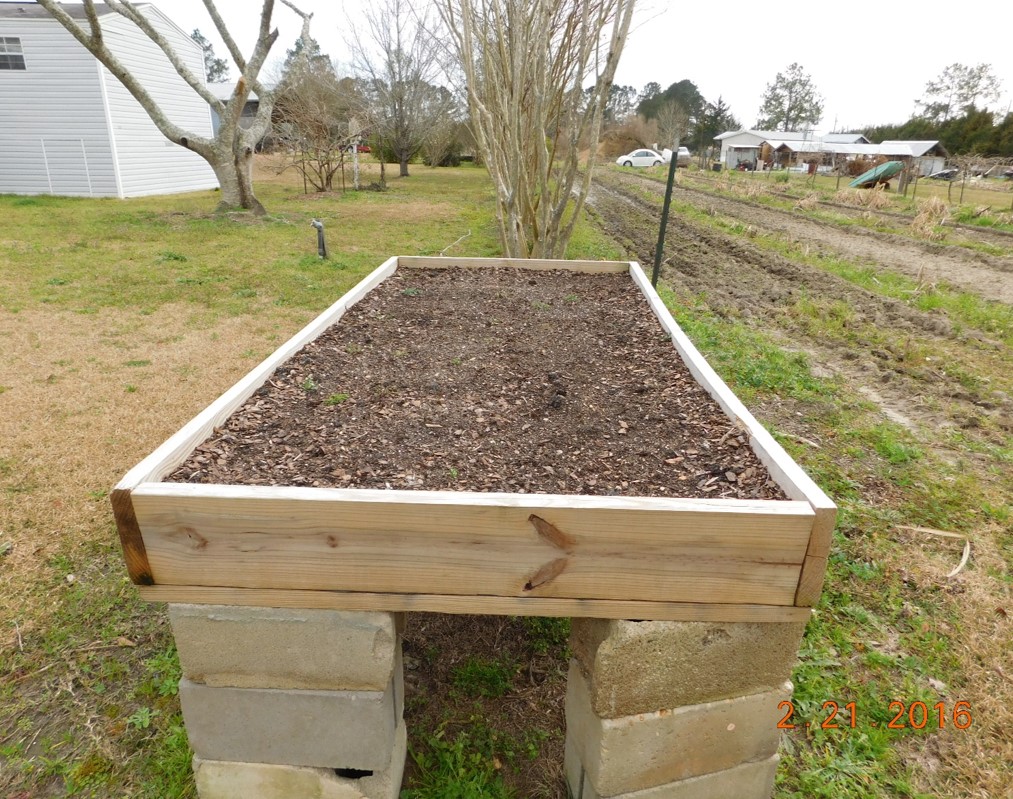
by Daniel J. Leonard | Oct 10, 2017
I had to do a hard thing last week. My battle-worn okra, eggplant and pepper plants that had produced so reliably since June and endured all the summertime challenges (heat, insects, disease, and a hurricane to name a few) were finally pulled out of my raised bed garden and discarded. A combination of lowered yields, increased insect pressure, and the fact that one can only eat so much okra in a calendar year sealed their fate.
However, before planting our cool-season veggie favorites, like those tender leafy greens and wonderfully crunchy carrots, there are a few things to do to get our raised beds in shape to give maximum yield performance and make growing a little easier.

Replenish the Soil
One of the main benefits of raised beds is the ability to grow in near-perfect soil conditions. If I was relegated to gardening in my yard’s less than ideal native sandy soil, I might have given up altogether by now and I suspect many of you would be in the same boat. Raised beds totally alleviate this problem and give gardeners the opportunity to grow in rich, fertile soil composed of your favorite homemade soil mixture (mine is two parts mushroom compost to one part aged pine bark) or commercial potting mix/compost. However, at the end of each growing season, you will notice you have a bit less soil in your beds than you did at the beginning. While frustrating, this is a natural process for soils rich in organic material – they naturally break down and decompose! So to give your veggies’ roots the maximum amount of growing space for the coming season, top off your beds with a quality soil/compost mix and till it in before sowing seed or setting out transplants.
Eliminate Competing Roots
If you have a mature tree anywhere near your raised bed garden, you are going to be in for a surprise when you till that new compost in! It turns out that tree roots like that rich, fertile raised bed soil just as much as vegetables do and will seek it out. It is not uncommon for mature trees to have root systems that stretch horizontally two to three times the height of the tree, meaning a 50’ oak tree could have roots growing well over a hundred feet away from its trunk! Therefore, unless you have a totally tree-free property, battling tree roots in your beds will be an ongoing issue. For instance, each fall, when I transition from warm season to cool season crops, I find that my neighbor’s Laurel Oak has filled all three of my raised beds full of feeder roots glad to be free of the infertile sand. This is a problem because those roots suck up vital water and nutrients meant for my vegetable crops, robbing them of reaching their full potential. It is good practice to thoroughly till your beds’ soil and remove as many of the competing roots as you can. Doing so will give your new plants a head start on becoming established before the competition returns.
Depleted soil and competition from tree roots are two of the biggest threats to your raised bed’s performance. By planning ahead and accounting for both of these things prior to planting your fall garden, you will be more likely to reap a larger yields when harvest time comes! For more information on raised bed vegetable gardening and other horticultural questions, contact your local UF/IFAS Extension Office. Happy fall gardening!
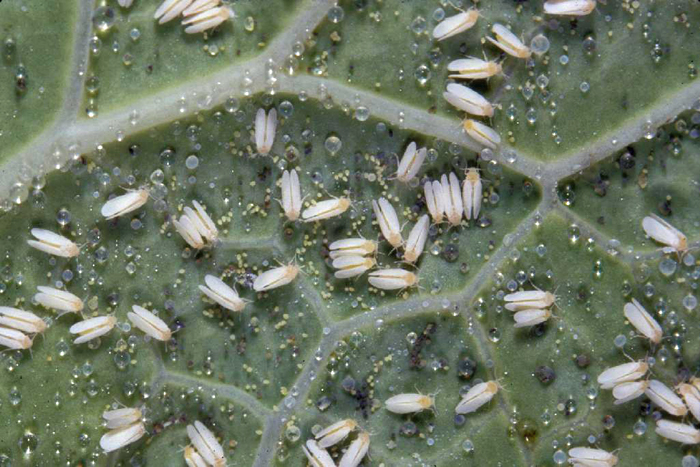
by Matt Lollar | Oct 2, 2017
Over the last month or so, home gardeners and commercial growers alike have noticed what look to be large dust particles floating through the air. It’s probably not uncommon to have inhaled a few or even a few hundred of these mysterious particles. Most likely, these “particles” aren’t dust at all but whiteflies instead. Whiteflies are small (less than a tenth of an inch long), white, soft-bodied insects. They aren’t flies but are considered ‘true bugs’ by entomologists. The most common whitefly species in Northwest Florida is the silverleaf whitefly, also known as the sweetpotato whitefly. Whitefly numbers have exploded exponentially this year because of last years’ mild winter. These irksome insects feed on a variety of annuals, shrubs, vegetables and trees.

Magnified whitefly adults and eggs. Photo Credit: James Castner, University of Florida/IFAS.
Whiteflies typically feed on the underside of leaves. Initially, disturbed leaves will become pale in color, then a sticky substance may develop on the surface of the leaves. This sticky substance is called honeydew. Honeydew is actually a sugary substance excreted by the whiteflies as part of their elimination process, similar to what aphids and scale insects produce. After honeydew is deposited, sooty mold develops to feed on this readily available sugar source. Sooty mold is a fungus that forms a gray to black colored coating on plant leaves. It normally grows on leaves that were previously covered with honeydew. Sooty mold hinders the ability of leaves to absorb light and ultimately limits photosynthesis.
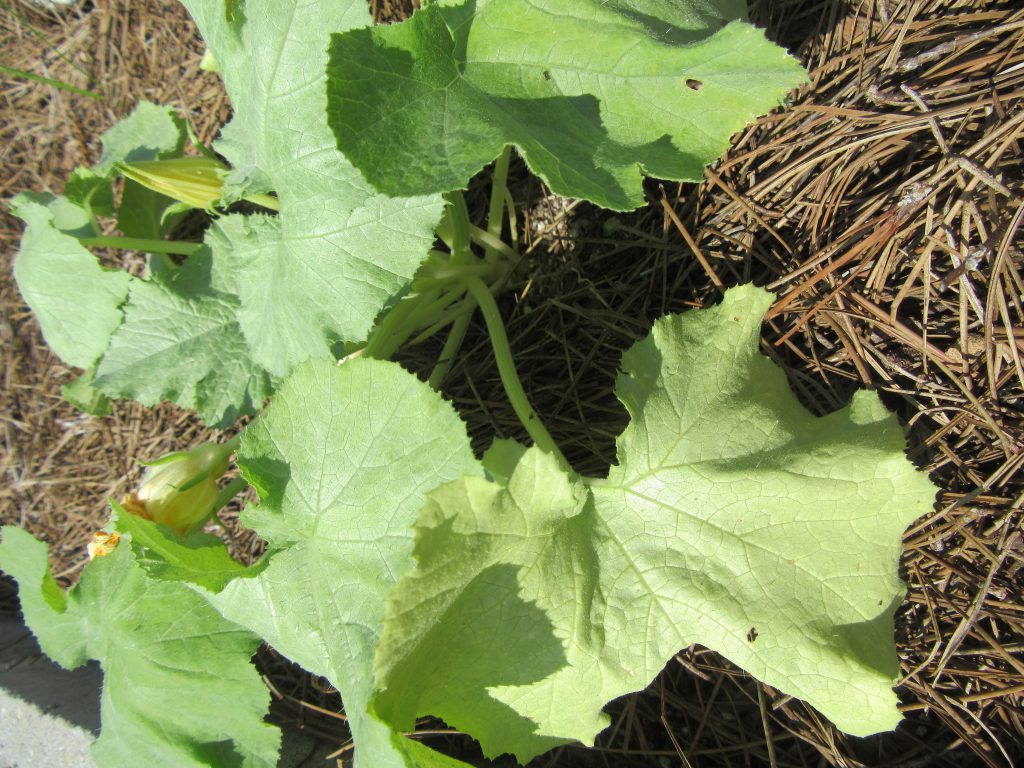
Pale squash leaves due to feeding from whiteflies. Photo Credit: University of Florida/IFAS.
So what should be done to control whiteflies? It depends on what is being grown. If whiteflies are present, the role of beneficial insects should be taken into consideration. Plenty of predatory insects such as lady bugs and green lacewings are around to feed on whiteflies. In fact, leaving the whiteflies alone on your trees and shrubs will attract more predatory insects. Below are some whitefly control methods that produce minimal damage to beneficial insect populations.
Whitefly Control in Vegetables
- Sticky Traps – Yellow sticky traps are a good way to monitor whitefly populations and can help determine when insecticide application is appropriate.
- Insecticidal Soaps – Insecticidal soaps are usually applied as a 1 to 2 percent solution (2½ to 5 tablespoons per gallon of water). It is important to follow the application directions on the label. Insecticidal soap should be applied in the evening, when the sun is low in the sky and the temperature is below 85°F. Some insecticidal soaps available at local lawn and garden centers include: Bonide Insecticidal Soap, Bonide Insecticidal Soap, and Bayer Advanced Natria Insecticidal Soap.
- Horticultural Oils – Horticultural oils should be handled like insecticidal soaps. Like the soaps, they should be applied in the evening. Some horticultural oils available at local lawn and garden centers include: Bonide All Seasons Spray Oil, Southern Ag Parafine Oil, and Garden Safe Neem Oil.
- Other Insecticides – Harsher chemicals are not recommended for the home gardener, because whiteflies have become resistant to most products on the market. Use of broad spectrum insecticides may also contribute to an increase in whitefly populations because they kill beneficial predatory insects.
Hopefully winter will be cooler this year and the profuse whitefly population will be knocked back. Until then, we wish all home gardeners the best of luck with fall gardening!
by Beth Bolles | Sep 8, 2017
Trees are a valuable resource. They add beauty to our community, serve as food and shelter for animals, filter the air, and cool urban environments. Trees can also be a liability when poorly maintained, damaged, or diseased. There are often times when an arborist is needed to help determine the best course of action for the tree.
There are many individuals who are involved in the tree care and removal business. Not all of these people are certified in the care of trees. Arborists are people who receiving training in the planting, care, and maintenance of trees.
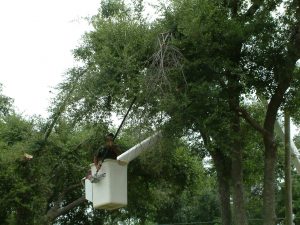
Professional arborists have specialized training to create safe, structurally sound trees, even when damaged by storms. Photo by Beth Bolles, UF IFAS Extension Escambia County
Certified arborists go through a voluntary certification process with the International Society of Arboriculture which means that they have at least three years experience and have passed a comprehensive examination developed by tree experts. A certified arborist maintains certification by attending regular training courses.
An arborist may also be a member of another organization which helps professionals stay up-to-date on tree care techniques and information. These include the National Arborist Association and the American Society of Consulting Arborists.
Hiring an arborist to work on your trees is important for several reasons. An arborist can evaluate the tree and determine the steps necessary to create a healthy specimen. In regards to pruning, the professional will determine what type of pruning is necessary and remove branches properly.
Professionals will also perform tree care practices that are recommended by University research. A few practices that the arborist would not perform include topping trees, using climbing spikes on trees which are not being removed, and making flush cuts against the trunk.
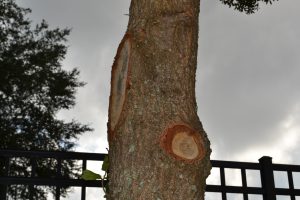
Flush cuts are damaging to trees and can create a future hazard in your landscape. Photo by Beth Bolles, UF IFAS Extension Escambia County
Finally arborists have the skills and equipment to safely and efficiently prune or remove trees. This includes personal and property damage insurance and workers compensation insurance.
Next time you need tree work or advice, hire a professional for the job. It will definitely be worth the investment.
by Matt Lollar | Aug 25, 2017
If you’ve attended any of our landscaping classes, then you’ve probably heard the phrase “Right Plant, Right Place”. This phrase is a simple reminder to research plant growth habits and growing conditions before making selections for your landscape. This not only holds true for ornamental plants, but for edible crops as well. A term used to describe the use of edibles as ornamentals is “Permaculture”. Now this is an extremely simplified definition of the term, but permaculture comes from a combination of the words “permanent” and “agriculture”. The thought behind permaculture is to fashion an edible landscape after a natural ecosystem.
There are a number of strategies to becoming a successful permaculturist. Below you will find a few examples.
- Site Observation and Analysis – The slope, orientation to the sun, and sectors of your yard should all be documented.
- Slope – Identifying the slope of your yard can help you determine the natural flow of water and nutrients. For example, if you have a hill in your back yard you may want to install some plant beds between the peak of the slope and your house. These beds will help absorb water and nutrients before they have a chance to reach the house.
- Orientation – Think about the location, relevant to your house, of each of your edible landscape areas. The eastern side of your house receives morning sunlight, which is much cooler than the western side of your house that receives sunlight in the afternoon. A tomato plant will be much happier if it can avoid the afternoon heat.
- Sectors – While walking your property, you will notice differences in soil texture, soil moisture, and the plants and weeds growing in these different areas. You can divide your yard based on these characteristics along with slope, orientation, and shade percentage to develop sectors of your property.
 Cover Crops and Living Mulch – Cover crops are planted in areas that you would normally allow to go fallow. Living mulches are plants that are planted alongside edible plants to help fill voids. The benefits of both are listed below.
Cover Crops and Living Mulch – Cover crops are planted in areas that you would normally allow to go fallow. Living mulches are plants that are planted alongside edible plants to help fill voids. The benefits of both are listed below.
- Weed Supression
- Erosion Control
- Produce and/or Scavenge Nutrients
- Nematode Supression
- Harbor Beneficial Insects
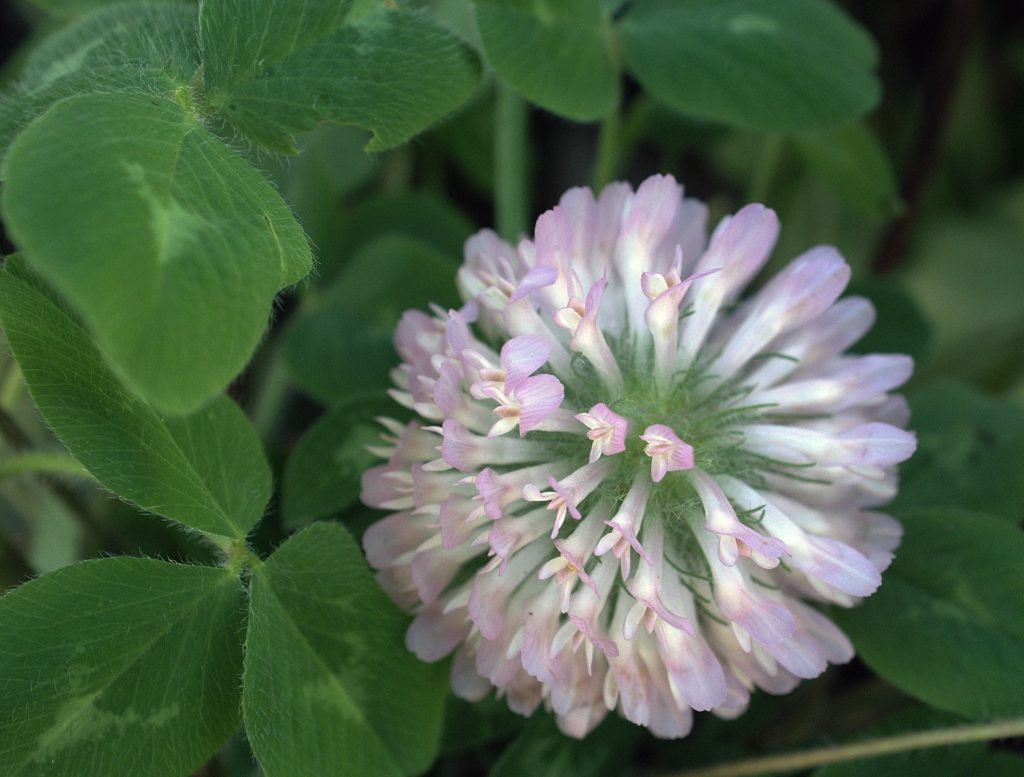
Clover is an excellent cover crop choice and has a beautiful flower. Photo Credit: University of Florida/IFAS.
- Space Utilization – The third criteria is to mimic a forest. Just like any good forest, your “forest garden” will consist of different layers of vegetation.
- You can start by planting large deciduous trees such as pecans or pears farthest from the house. These trees will allow filtered light to penetrate the layer below.
- Next, you can plant smaller fruit trees such as citrus or peaches along the understory of the larger trees.
- Then, you can plant your vegetable and herb garden around your fruit tree plantings.
- Finish by planting root and vining vegetables such as carrots or sweet potatoes at the edge of the forest.
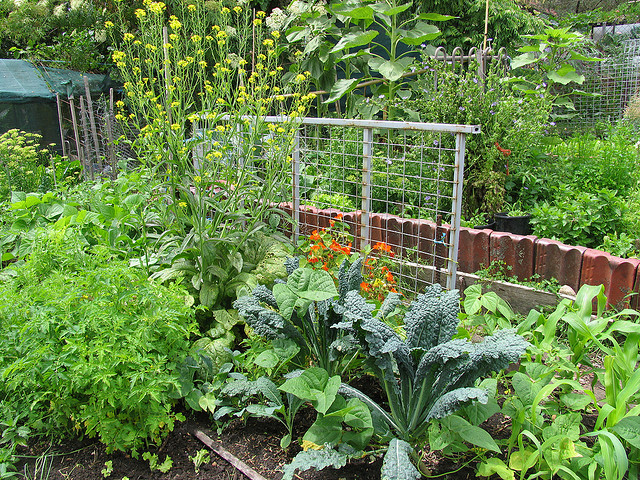
A mixed vegetable garden. Photo Credit: eXtension.org.
We’ve just scratched the surface of the concept of permaculture, but I encourage you to dig a little deeper. What could be the harm with being able to eat your landscape? Just don’t eat too much or you may lose your landscape entirely!
An “Intermediate Permaculture” class is scheduled for Saturday, September 23 at the Jackson County Extension Office. For more information, please call (850)-482-9620 and ask for Matt.
For more information on permaculture please visit the NC State Permaculture Page.
For more information on “Right Plant, Right Place” please visit the UF/IFAS Florida Friendly Living Site.

 If you are a regular reader of Gardening in the Panhandle, you know that this e-newsletter covers many topics related to ornamental and vegetable gardening, Florida-friendly landscaping, pest management, and lawn and garden fertility.
If you are a regular reader of Gardening in the Panhandle, you know that this e-newsletter covers many topics related to ornamental and vegetable gardening, Florida-friendly landscaping, pest management, and lawn and garden fertility.









